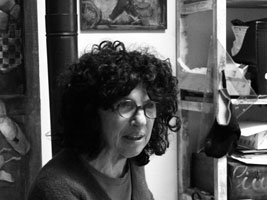Imelda’s biography by Sergia Mozzo



The artist was born in Vicenza, where her artistic formation was determinant, from the choice of studies to the subsequent research of different working settings in the creative-artistic sphere, from graphic and advertising studios to design and fashion houses.
She started painting almost for fun and, always for fun, in 1970 as soon as she finished her studies, she presented her first canvas which she depicted at an extemporaneous painting contest in Vicenza. It was a colourful autumn abstraction with half of an Ionic capital column coming out of it; it simulated Palladio’s portico of Villa Capra (la Rotonda) just outside the city on the Colli Berici. The work was only reported by the critics but that was enough to encourage her to continue, or rather to start painting.
However she started to work (to earn a leaving of course) in a wood painting laboratory in Cittadella, conceived and run by Francesco Conz. She was immediately appreciated for her capability, originality and sharpness. She would stay there for six years and in this very laboratory, known and active all over Europe, she will gain a stylistic knowledge that will be the foundation of her future research work.
The change was difficult, because in those years - even if she painted every day - she was doing only what she was required. In the evening and at night, freeing herself from any canon or scheme, she would go back to her brushes and her worlds until, without fully realizing it, in 1976 she entirely left canvases and abstractionism. She also left Francesco Conz to dedicate her life to her new job with the inspiration, enthusiasm and professionalism that everybody will then recognize.
Having moved to Savona for family reasons, in December 1979 she decides to open a workshop-atelier of antique painting on wood in the centre of the city that was giving her hospitality. A dream that she always had – to be able to dedicate her time completely to the “making”. The place was called “La Mela” (The Apple). She explains that in those years all artists-craftmen used to call their laboratory with similar names, like: The Moon, the Pomegranate, The Woodworm, The Bagatto (the magician of tarots) etc. etc.
"The Apple" is a simple name, without any particular reference, but for her this identification contains an ancient formula, the one about a real workshop, where you could find the artist, the assistant, the pupil and various collaborators. Because the one who creates is never alone or maybe he just pretends not to be alone. There, in the very centre of Savona, until 1990 she actually develop an original and unmistakable pictorial elaboration. A kind of work that differs from the themes and materials of the present and massive ceramic tradition. Then the need of larger and more comfortable spaces induces Imelda Bassanello to move her atelier to Santuario, where she already lives (about 6 km from the city centre).
This particular and charming spot rigorous and collegial, becomes for her the real place - maybe always idealized - a cradle of rest and ideas which come out spontaneously through the people, the children who follow the artist’s call and invitation to paint on the walls, fences, doors, on nativity in procession. The village little by little transforms; it becomes a laboratory itself.
And she continues to paint. You can almost say that there is no material that cannot be touch by her brush, but the happiest meeting remains always the wood. In her job she had many requests for premises signs (bar, restaurants…) that you can still see around Italy and Europe. The passion for woods penetrates even more when she senses the direct relationship with space - above all public space. After the manufacturing and the setting of the various signs in the landscape, in the colour and street perspective, she discovers the doors, the street doors.
Old and abandoned - the first ones just in Liguria, where deterioration, neglect and indifference start to be Imelda’s major irritating enemies. From here she gets a new input which leads her to paint doors (mostly for free) in the whole region choosing the most inconceivable to a possible reinstatement; doors of disused warehouses, stables, old houses until she arrives in Vallecrosia – Imperia where the Mayor place an order for about 25 doors of the old village at a time. It’s an ideal victory, a slow journey through daily experiences in thinking and wood, with all its nuances and grains.
To give an identity to the area the artist chooses a theme that, with coherence, runs through the streets of the shop-less village inventing imaginary stores: the smile one, the one about dreams, about chats, celestial music, games, artists, but also blacksmith, cobbler, sailor etc.
Among exhibitions and realisation of work in various places (we recall the gigantic work carried out in two restaurants/bars in the Canary Islands, in Switzerland, in Germany and in the South of Spain) she is not regularly in her studio which nevertheless continuous its real existence and production despite everything. In fact it remains a fixed point in all aspects, a compelled island, a potential shelter, a home.
Sergia Mozzo, from A fra arte e desing, no. 36, January/March 2000
